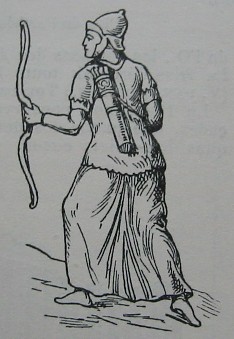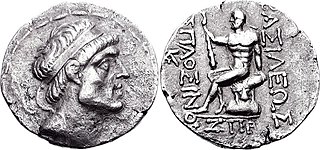Related Research Articles

The Parni, Aparni or Parnians were an East Iranian people who lived around the Ochus (Tejen) River, southeast of the Caspian Sea. It is believed that their original homeland may have been what is now southern Russia, from where they emigrated with other Scythian tribes. The Parni were one of the three tribes of the Dahae confederacy.

Mithridates I, also known as Mithridates I the Great, was king of the Parthian Empire from 165 BC to 132 BC. During his reign, Parthia was transformed from a small kingdom into a major political power in the Ancient East as a result of his conquests. He first conquered Aria, Margiana and western Bactria from the Greco-Bactrians sometime in 163–155 BC, and then waged war with the Seleucid Empire, conquering Media and Atropatene in 148/7 BC. In 141 BC, he conquered Babylonia and held an official investiture ceremony in Seleucia. The kingdoms of Elymais and Characene shortly afterwards became Parthian vassals. In c. 140 BC, while Mithridates was fighting the nomadic Saka in the east, the Seleucid king Demetrius II Nicator attempted to regain the lost territories; initially successful, he was defeated and captured in 138 BC, and shortly afterwards sent to one of Mithridates I's palaces in Hyrcania. Mithridates I then punished Elymais for aiding Demetrius, and made Persis a Parthian vassal.

Vologases I was the King of Kings of the Parthian Empire from 51 to 78. He was the son and successor of Vonones II. He was succeeded by his younger son Pacorus II, who continued his policies.

Vardanes I was a king of the Parthian Empire from 40 to 46 AD. He was the heir apparent of his father Artabanus II, but had to continually fight against his brother Gotarzes II, a rival claimant to the throne. Vardanes' short reign ended when he was assassinated while hunting at the instigation of a party of Parthian nobles.

Arsaces II, was the Arsacid king of Parthia from 217 BC to 191 BC.

Osroes I was a Parthian contender, who ruled the western portion of the Parthian Empire from 109 to 129, with a one-year interruption. For most of his reign he contended with the rival king Vologases III who was based in the eastern provinces. In 116, Osroes I was briefly ousted from his throne at Ctesiphon during an invasion by Roman emperor Trajan, who installed Osroes' son, Parthamaspates. After Trajan's death the following year, Osroes I's rule was reinstated by the Parthian nobility. In 129, he was removed from power by Vologases III.

Characene, also known as Mesene (Μεσσήνη) or Meshan, was a kingdom founded by the Iranian Hyspaosines located at the head of the Persian Gulf mostly within modern day Iraq. Its capital, Charax Spasinou, was an important port for trade between Mesopotamia and India, and also provided port facilities for the city of Susa further up the Karun River. The kingdom was frequently a vassal of the Parthian Empire. Characene was mainly populated by Arabs, who spoke Aramaic as their cultural language. All rulers of the principality had Iranian names. Members of the Arsacid dynasty also ruled the state.
The Battle of Ecbatana was fought in 129 BC between the Seleucids led by Antiochus VII Sidetes and the Parthians led by Phraates II, and marked the final attempt on the part of the Seleucids to regain their power in the east against the Parthians. After their defeat, the territory of the Seleucids was limited to the area of Syria.

Istakhr was an ancient city in Fars province, five kilometres north of Persepolis in southwestern Iran. It flourished as the capital of the Persian Frataraka governors and Kings of Persis from the third century BC to the early 3rd century AD. It reached its apex under the Sasanian Empire, and was the hometown of the Sasanian dynasty. Istakhr briefly served as the first capital of the Sasanian Empire from 224 to 226 AD and then as principal city, region, and religious centre of the Sasanian province of Pars.

The Parthian Empire, also known as the Arsacid Empire, was a major Iranian political and cultural power in ancient Iran from 247 BC to 224 AD. Its latter name comes from its founder, Arsaces I, who led the Parni tribe in conquering the region of Parthia in Iran's northeast, then a satrapy (province) under Andragoras, who was rebelling against the Seleucid Empire. Mithridates I greatly expanded the empire by seizing Media and Mesopotamia from the Seleucids. At its height, the Parthian Empire stretched from the northern reaches of the Euphrates, in what is now central-eastern Turkey, to present-day Afghanistan and western Pakistan. The empire, located on the Silk Road trade route between the Roman Empire in the Mediterranean Basin and the Han dynasty of China, became a center of trade and commerce.

Touraj Daryaee is an Iranian Iranologist and historian. He currently works as the Maseeh Chair in Persian Studies and Culture and the director of the Dr. Samuel M. Jordan Center for Persian Studies at the University of California, Irvine.

Alireza Shapour Shahbazi was a prominent Persian archaeologist, Iranologist and a world expert on Achaemenid archaeology. Shahbazi got a BA degree in and an MA degree in East Asian archaeology from SOAS. Shahbazi had a doctorate degree in Achaemenid archaeology from University of London. Alireza Shapour Shahbazi was a lecturer in Achaemenid archaeology and Iranology at Harvard University. He was also a full professor of archaeology at Shiraz University and founded at Persepolis the Institute of Achaemenid Research in 1974. After the Islamic revolution, he moved to the US, firstly teaching at Columbia University and then later becoming a full professor of history in Eastern Oregon University.

Andragoras was an Iranian satrap of the Seleucid provinces of Parthia and Hyrcania under the Seleucid rulers Antiochus I Soter and Antiochus II Theos. He later revolted against his overlords, ruling independently from 245 BC till his death.
House of Suren or Surenas is one of two Parthian noble families explicitly mentioned by name in sources dateable to the Arsacid period.

Parthia is a historical region located in northeastern Greater Iran. It was conquered and subjugated by the empire of the Medes during the 7th century BC, was incorporated into the subsequent Achaemenid Empire under Cyrus the Great in the 6th century BC, and formed part of the Hellenistic Seleucid Empire after the 4th-century BC conquests of Alexander the Great. The region later served as the political and cultural base of the Eastern Iranian Parni people and Arsacid dynasty, rulers of the Parthian Empire. The Sasanian Empire, the last state of pre-Islamic Iran, also held the region and maintained the seven Parthian clans as part of their feudal aristocracy.

The Aswārān, also spelled Asbārān and Savaran, was a cavalry force that formed the backbone of the army of the Sasanian Empire. They were provided by the aristocracy, were heavily armored, and ranged from archers to cataphracts.
The Cambridge History of Iran is a multi-volume survey of Iranian history published in the United Kingdom by Cambridge University Press. The seven volumes cover "the history and historical geography of the land which is present-day Iran, as well as other territories inhabited by peoples of Iranian descent, from prehistoric times up to the present.

Hyspaosines was an Iranian prince, and the founder of Characene, a kingdom situated in southern Mesopotamia. He was originally a Seleucid satrap installed by king Antiochus IV Epiphanes, but declared independence in 141 BC after the collapse and subsequent transfer of Seleucid authority in Iran and Babylonia to the Parthians. Hyspaosines briefly occupied the Parthian city of Babylon in 127 BC, where he is recorded in records as king (šarru). In 124 BC, however, he was forced to acknowledge Parthian suzerainty. He died in the same year, and was succeeded by his juvenile son Apodakos.

In 245 BC, Andragoras, the Seleucid governor (satrap) of Parthia proclaimed independence from the Seleucids, when - following the death of Antiochus II - Ptolemy III seized control of the Seleucid capital at Antioch, and "so left the future of the Seleucid dynasty for a moment in question."

Meherdates was a Parthian prince who competed against Gotarzes II for the Parthian crown from 49 to 51 AD. A son of Vonones I, he was ultimately defeated and captured by Gotarzes II, who spared him, but had his ears mutilated, an act that disqualified him from inheriting the throne.
References
- ↑ EnWiki.NET - Encyclopædia Britannica Ultimate (2010). Adrian David Hugh Bivar. Retrieved on 2010-04-17.
- ↑ Encyclopaedia Iranica (2010). Iranian Studies in Britain, Pre-Islamic. Retrieved on 2010-04-17.